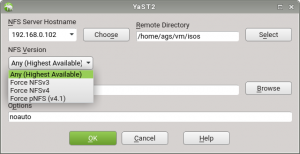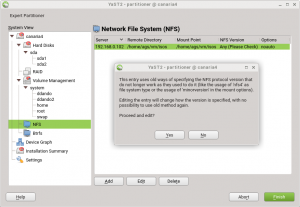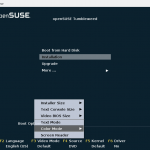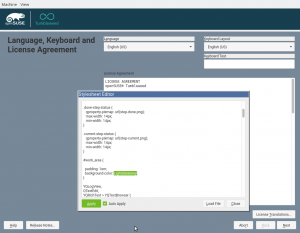Time flies. We are almost in May and the openSUSE Conference ’18 is around the corner. So after booking your flights (if you need to) and your acommodation, you might want to know what happened in the YaST world during the Development Sprint 55th.
The YaST team is currently polishing the upcoming release, introducing some improvements and fixes. There are no breaking changes but still we have a lot of things to blog about.
Updating NFS Version Handling
Once upon a time, back in 2008 to be precise, the Large Hadron Collider (LHC) was finally ready, Raúl Castro replaced Fidel as President of Cuba, the TV show Phineas and Ferb was previewed… and yast2-nfs-client added support to configure NFSv4 mounts. Back then, the proper way of doing that was using “nfs4” as type for mounting the NFS share, i.e. writing “nfs4” in the vfstype column of the /etc/fstab file. Some time later, NFS4.1 (also known as pNFS) came out, and a new mount option “minorversion=1” was added. Very soon it was clear that such solution was not scaling and was not the way to go.
So at some point “nfs4” was deprecated as acceptable value for vfstype and “minorversion” was ditched in favor of “nfsvers”. Since the old deprecated way of doing things was still working, yast2-nfs-client was never updated to reflect this. But starting with the upcoming Leap 15 and SLE 15, some things will change in NFSland (in fact, the change landed in openSUSE Tumbleweed some time ago already). The type “nfs4” will be considered identical to “nfs” and “minorversion” will be completely ignored, so your old NFS mounts may not work as you expect them to do it. Time to refresh yast2-nfs-client!
During this sprint, yast2-nfs-client was not only fixed internally to produce valid entries in /etc/fstab, it also got a slightly revamped form to create and edit NFS mounts that should be less confusing than the old one and also more explanatory about how NFS versioning really works when defining a mount.
To ensure our users don’t get fooled by old entries that seems to be enforcing a particular NFS version (because they use “nfs4” as mount type, for example), but are in fact not doing it due to the new behavior in SLE 15 and openSUSE 15, yast2-nfs-client is now able to detect such circumstance, mark such entries in the list and offer a safe migration path to users.
As you can infer from the screenshot above, all these improvements are available when yast2-nfs-client runs standalone, as well as when it runs embedded within the YaST Partitioner. Enjoy!
Fixing Broken Translations
Recently we got some bug reports about YaST crashing at some points when running in some specific locales. It turned out that the problem was caused by broken translations.
A lot of translated texts contain placeholders like %s, %{text} or %1. These tags are replaced by the real values by YaST. But that requires that the translated text contains the same tags. If they are missing the value will not be included and, what is even worst, if they are invalid the Ruby interpreter throws an exception which means YaST aborts making our users unhappy. And that’s really bad, right?
Unfortunately the Ruby gettext does not support format tags and the GNU gettext does not support Ruby at all. As a quick solution we wrote a script which checks whether all tags are included in the translated text and reports broken translations.
The script found about 160 broken translations. The most common problems were usually just typos (s% instead of %s, {%foo} instead of %{foo}, or extra space in %␣1). But some cases were not that trivial. Translators by mistake also used the Unicode ٪ instead of the ASCII % or even translated the tags, which must stay untouched (%{مساعدة}).
Some translations were obviously wrong or even contained the original English texts – we removed them. In some cases the tags were wrong but we were not sure whether the whole translation is valid. In that case instead of fixing the tags we removed the translated text completely. It is better to ask the translators for translating again than have a completely invalid translation.
In the future we plan to improve these checks, so the tags are properly handled by Ruby and/or GNU gettext directly and we do not need a separate script for that.
Installing Over VNC Using the Browser
You are surely accustomed to remote administration using SSH. And, as you may know, the (open)SUSE installation can be done over SSH too. But, additionally, YaST also have support for installing over VNC.
When using VNC for installation, you can choose between using a native VNC viewer or a web browser based one. The cool thing about the second option, is that you can follow the installation just pointing your browser to http://IP-ADDRESS:5801.
Until now, YaST was using a Java applet based implementation, which is no longer supported in browsers. But during this sprint, we have completed the switch to a JavaScript based solution.
Unfortunately, that has resulted in losing an encryption layer: the HTTP connection on port 5801 is unencrypted, but the typical VNC port (5901) continues to be encrypted.
Asking Once About Equivalent Licenses
After splitting SUSE Linux Enterprise in several modules, it was pretty common that the user had to accept a couple of equivalent licenses during the installation process. Given that the content for those licenses was pretty much the same, it was quite confusing. Actually, we got a bug report about the installation process being stuck asking the user to accept the license over and over (it was just the same license being shown for different modules).
In order to make our users happy, YaST is now able to decide whether two licenses are the same and, in that case, it will only ask once for acceptance. For the time being, YaST applies a hash function to license contents and compare the result, but most likely this mechanism will be refined in the future.
License Confirmation in CaaSP 3.0
And talking about licenses, another small change about how they are handled was introduced in CaaSP 3.0. As you know, CaaSP features a One Dialog Installer and there was no room for the license to be shown. Now, before proceeding with the installation, YaST will show the license in the confirmation screen if needed.
Improving the addon Boot Option Handling
Back in February, we improved the addon boot option to handle the SUSE Linux Packages DVD properly. However, during testing, we found out that if you are using a system which only has one DVD drive, the installation DVD will be automatically used as an addon.
In order to fix this conflict, if the installation media and the Packages DVD are going to use the same drive, YaST will ask the user to change the DVD before using it as an addon.
Additionally, we improved the documentation of the addon boot option adding new examples to clarify how the dvd:/// URLs are handled.
Echoes of Winter: White Text on a White Background
These days we fixed a bug that only allowed clairvoyant users to finish the installation of openSUSE Kubic.
The bug is pretty unremarkable but may we draw your attention to the related CSS styling engine? It powers the high-contrast color mode that you can select with F3 or with Y2STYLE:
and if you press Ctrl-Alt-Shift-S (for style) you can change the styling on the fly, as in this example of changing the background color:
Conclusions
openSUSE Leap 15.0 release is approaching and, as usual, we need help from our dear users to give testing versions a try and report bugs. Thanks in advance!
Both comments and pings are currently closed.





